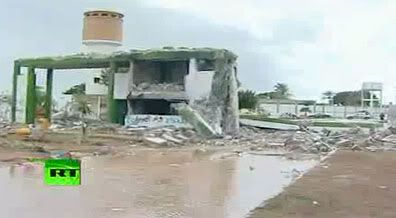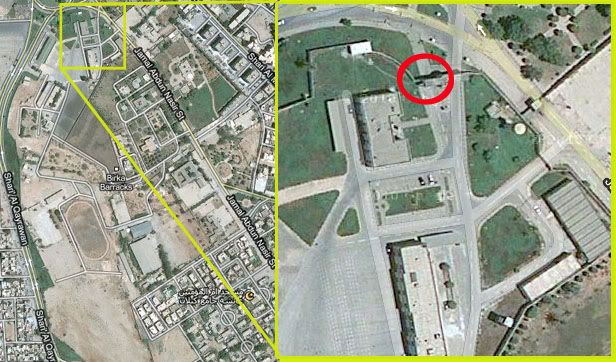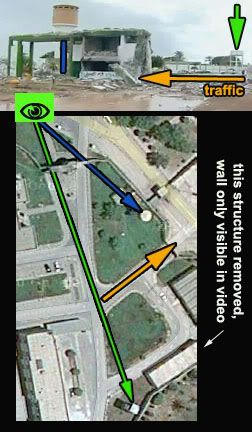last edits, September 30, 2011
Note Sept. 30: When I first wrote this piece I did not know the formal name of the military barracks in question here. It's often called the Katiba, as used below, but that just means something like "brigade." But it's called the Al-Fadhil bin Omar barracks, at the time housing a brigade of that name.
Three months ago the other day, the Katiba barracks fell to what was becoming the Libyan rebel army. The large, loyal, and well-stocked military base in the middle of Benghazi would arm much of rebel-held Cyrenaica after defection of general Abdel Fatah Younes there on February 21. This came the day after the base's main gate was blown open, triggering a fierce battle within the sprawling complex. The swift culmination of that episode was a major turning point in the fate of the city, Libya's second largest and soon the de facto rebel capitol.
This post focuses on the opening of the gate by an act that, in any other context, would be denounced by the Western media as an act of terrorism. Consider this still from a Russia Today broadcast, showing the effects of a very powerful blast:
Further images of the damaged gate can be seen here, here and here.
Al Jazeera had an excellent photo but nothing much on the cause, mentioning this suicide bomber not at all.
A gaping hole in the northern wall of the compound, all twisted metal bars and jagged concrete blocks, marks the spot where protesters first managed to push through under a hail of gunfire. In white spray-paint, someone has written "Martyrs' Square" in Arabic on an unhinged metal gate that hangs off the breach.But others give due mention of Mahdi Ziu, the middle-aged executive turned Jihadist. The Guardian, for one, reported two months later:
Ziu was not classic suicide-bomber material. He was a podgy, balding 48-year-old executive with the state oil company, married with daughters at home. There was no martyrdom video of the kind favoured by Hamas. He did not even tell his family his plan, although they had seen a change in him over the three days since the revolution began.But Mr. Ziu (see tribute poster at left, from here) did drive an explosive car, we're told, from within a funeral procession, right at the Katiba's north gate and blew it open, probably killing some guards and helping make the heavy weapons inside available to all sorts of riff-raff. The Guardian's use of plastic language re-brands what elsewhere wouldbe termed a disaster and a heinous crime:
The Middle East. A man with a car fashioned into a bomb. He disguises his intent by joining a funeral cortege passing the chosen target. At the last minute the man swings the vehicle away, puts his foot down and detonates the propane canisters packed into the car.Admittedly, it was a rather violent selflessness, with further violent effects.
It all sounds horrifyingly familiar. Mahdi Ziu was a suicide bomber in a region too often defined by people blowing up themselves and others. But, as with so much in Libya, the manner of Ziu's death defies the assumptions made about the uprisings in the Arab world by twitchy American politicians and generals who see Islamic extremism and al-Qaeda lurking in the shadows. Ziu's attack was an act of pure selflessness, not terror, and it may have saved Libya's revolution.
Then Ziu arrived, blew the main gates off the barracks and sent the soldiers scurrying to seek shelter inside. Within hours the Katiba had fallen.
[...]
What followed wasn't pretty. "(The revolutionaries) were beating Gaddafi people they captured, it's true. When they captured a Gaddafi soldier they said: 'What was this man doing? He was shooting us.' Gaddafi's soldiers wanted to kill anyone. They were using anti-aircraft weapons on humans. It cut people in half. People were angry," says Fasi. So angry that some of Gaddafi's soldiers were lynched. At least one was beheaded.
CNN reported the story a month earlier, but got the name a bit different, as Mendhi Ziu.
Confirmed: Hero Story of Benghazi Suicide Bomber
CNN reports that a man named Al Mendhi loaded his car with explosives and drove it into a military compound in Benghazi last week [...] Mr. Mendhi, a 49 year old oil company worker, is being hailed as a hero, because it was his sacrifice that enabled the resistance to overtake the barracks and roust Gadaffi's army, ultimately regaining the city of Benghazi. He had filled cylinders with cooking gas, packed them into his car, where he sat and prayed for half an hour before driving the car at high speed into the compound. His valiant efforts were not in vain.
Re-gaining Benghazi? When was it first lost?
His best friend reports that he carried the brave man's remains out of the car, and said that "If I didn't see it with my own eyes, I would not believe it myself."There was a car left? There were remains? Is this the car? It looks just about like an other car looted and burned within the compound. It doesn't look blown up by the blast center responsible for ruptiuring the concrete gate building. I'm no explosives expert, but there seems ample room to wonder whether this was the result of exploding gas canisters at high speed, or of something quite a bit more professional-grade.
For what it's worth, I confirmed the location from imagae analysis of the Russia Today footage. By background structures, I decided it's clearly the north gate, the west lane (inbound?) passage. These images show my work.
Update, Sept. 30: This historic bombing of the north gate and guard house - either the actiual blast or the destruction after - is something that, like protesters being shot, is simply absent from " "protester" videos. Russia today showed it, outside media showed it, but somehow the people who did it seem to have kept it mum,as if that would help us fail to notice they were"protesting" places to smithereens.
It also has a way of being glossed over or ignored in mainstream run-downs of the battle for Benghazi. For example, the UN's Human Rights Council issued a report on June 1 (PDFlink) about the early violence. It could and should have addressed this particular act but somehow missed it. They make note of an extracted "admission of involvement by a member of the security forces," in rebel detention, "in the random shooting of protestors in Benghazi on 20 February."
Their statistics show the biggest spike of daily deaths that day - 60 to the previous 20 and 20 (on the 17th and 19th). But they thought this was from an extreme, random-shooting punishment because "government opponents assumed control over the Katiba premises," in some unspecified way with no mention of a terrorist suicide bomber, "on 19 February!" No wonder their conclusions were so warped - these guys were confused on major events like this, which aren't even hard to figure out just with a Google search and no airfare required. The question remains whether this type of goof-up is accidental or part of some design.





